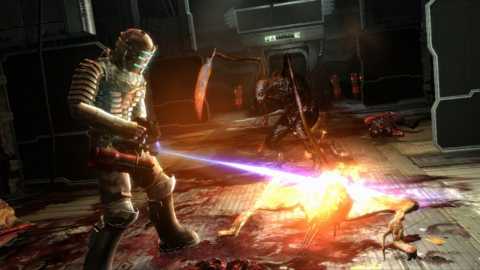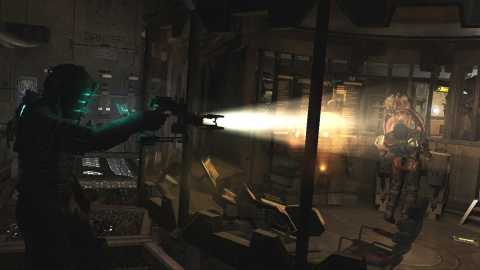Dead Space Review

Doom 3, check. System Shock 2, check. Gears of War, Resident Evil 4, check.
But all those blatant similarities didn't matter in the end. After finishing it, I felt stupid about knocking Dead Space for displaying its influences so prominently, because this game is pretty darn amazing.
The story isn't astoundingly original, but it does a fine job of moving you from one section of the ship to the next. You take the role of deep-space mining engineer Isaac Clarke, a member of a five-man crew dispatched to investigate the loss of contact with the USG Ishimura, an enormous "planetcracker" mining ship. Clarke's girlfriend was stationed on the Ishimura, so he has personal as well as professional reasons for getting in there and finding out what's going on. About five minutes after arriving, Clarke's own ship is toast, his five-man crew is down to three, and those three have been separated by a vile menagerie of creatures overrunning nearly every inch of the ship. Over the course of the game's 12 roughly hour-long chapters, your priorities will shift from saving the Ishimura to saving your own ass, and you'll barely fight your way through one tense, frantic monster attack after another as you try to escape the ship. The game is densely packed with spectacular moments from beginning to end, and the action is paced well enough that you never get bored or feel overwhelmed at any given moment.
It's easy to forgive a game for being derivative when it's presented with so much impact and it plays so damn well. Dead Space has some of the tightest, most well-balanced controls I've ever used in this kind of game. There are so many variables in a third-person shooter that contribute to the way it feels--the camera speed, the sensitivity of the analog sticks, the interval between hitting the aiming-mode trigger and actually being able to fire a gun--and I can't complain about any one of these factors in Dead Space; they all feel sublimely tuned and perfectly balanced to be easy to use and, above all, fun. You can hold a shoulder button to run, but unlike Gears' famed roadie run, you can still stop on a dime and break into a sidestep in an instant (or even run backwards). Everything about the moving, aiming, and shooting controls is superbly balanced and really entertaining.
The precision aiming required to properly dismember the enemies adds more depth to the combat than you'd get with most shooters, where you're just pumping rounds into a guy's torso or, at most, aiming for his head. Here, you'll want to specifically shoot for the knee to stop a fast-running monster from chasing you down, or shear off one of the smaller types of enemies' tentacles because they can fire spikes with them. The game's basic pistol weapon, the plasma cutter, even lets you orient its wide beam vertically or horizontally for more accurate slicing and dicing. Another weapon, the ripper, shoots a saw blade about eight feet in front of you and then just holds it spinning in midair, letting you rake it over an enemy and slice them up every which way. You can imagine the possibilities. With eight weapons on the roster and an alternate fire mode for each, there's a lot of variety in the carnage here.
Dead Space throws in a few more mechanics above the basic shooting action. You can telekinetically pick up and launch some objects as weapons, and you can also throw a stasis field to slow down an enemy briefly, making it easier to take their limbs off with precision. Both of these abilities are useful in fairly frequent environmental puzzles, some of them simple and some clever. I liked that the game didn't try to portray Isaac as a mining engineer...who also happens to have psionic abilities. Both of these abilities stem from devices in his suit, and that's that. 
This is a game you really need to play on a big high-def TV with a good, bass-heavy sound system. It's an audiovisual tour de force, with some of the moodiest and most impressive lighting effects on this generation of consoles. Some of the interior environments of the Ishimura are positively cavernous, or filled with massive thrumming machinery. There aren't a lot of boss encounters, but the sheer scale of a couple of them in particular left my jaw hanging open. The sound design is also extremely well done, not just for the ever-present creepy ambient backdrop, but also some of the in-your-face effects, like Isaac's sonorous gasping when he's badly hurt and out of breath, or that aforementioned grisly wet crunch of severed monster limbs. The sound effects have a real weight to them that beg to be conveyed over speakers with some serious muscle.
Dead Space would be a great game no matter who made it, but I'm more impressed with it since it's coming out of EA. That bastion of the annualized sequel is finally taking some risks with original games, if not always original ideas, and in this case the risk paid huge dividends. You've probably seen most of Dead Space's parts in other games from time to time, but you've rarely seen them assembled this well.
